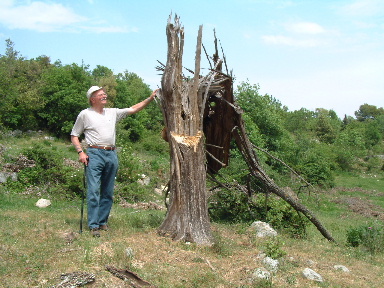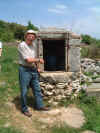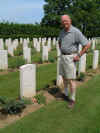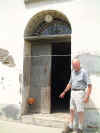RETURN TO ITALY
CASSINO TO FAENZA 1944 -
2003

John Dray served with the 5th Bn Northamptonshire
Regiment (78th Division) and 2/7th Queens (56th Division) in Italy from 1943-44.
He had joined up under age in 1943, but as he had volunteered he was allowed to
choose his unit. Although he was from Devon, John selected the Northamptonshires
as his father had fought with the regiment in the First World War. Following
training, he was posted to the 5th Battalion, part of 11th Brigade, 78th (Battle
Axe) Division following the Sangro River Battle in the autumn of 1943. In
December that year John celebrated his seventeenth birthday on active service.
The battalion was transferred to the Cassino front in May 1944,
and John's company took over positions on Snakeshead Ridge. They reached this
via the 'Jeep Head' a position north of Cassino town on the reverse slope of the
high ground in front of the Abbey, which was as far as a vehicle could go. From
here it was on foot or by mule. Once on the Ridge they occupied 'Sangars'; small
stone structures, which served as foxholes for the men in the line here.
Movement was restricted, but occasionally there was some patrol work. There were
also regular mortar bombardments - 'stonks' - but thankfully John's battalion
wasn't one of those thrown into an attack on the Abbey itself.
After Cassino, John took part in the advance up the Liri Valley,
where he and his battalion crossed the Rapido. In this action John served as a
company sniper. As they pushed up the valley, they witnessed the Poles take
Monte Cassino; John could remember seeing a flag go up on the ruins, which they
all thought was a Red Cross flag, but which was in fact a Polish one. Eventually
they reached the Acquino aerodrome, a circular airstrip with several wrecks of
Italian aircraft scattered around. While picking some grapes on the edge of the
aerodrome, John was wounded by a shot from a German sniper.
John soon returned to the battalion. Meanwhile Rome had fallen,
and the battalion moved to Monte Gabbione, where John took part in the fighting
there.
A rest in Egypt followed, and when the 78th Division returned to
Italy in September 1944, some men were sent as replacements to fill the ranks of
battalions which had suffered heavily in the fighting for the Coriano Ridge.
John therefore found himself posted from the 5th Northants to the 2/7th Queens,
of the 56th (Black Cat) Division.
John fought his last battle in Italy with 2/7th Queens on 7th
December 1944, in the advance on Faenza. Advancing through the orchard of a
small farm, a trip-wire was sprung and one soldier killed, and several wounded
by mines strapped to the trees. John was hit in the ankle, and dragged into the
nearby farm buildings. After being patched up, he was evacuated by jeep down a
road to the nearby Aid Station. The stretcher was on the bonnet of the jeep, and
John could remember looking down into the ditch by the road, seeing German
soldiers sheltering there!
From here John was passed down the evacuation chain to a large
base hospital, where his serious wound threaten his life on more than one
occasion. He was finally discharged in 1946. A regular visitor to the WW1 and
WW2 battlefields all over Europe, where he often worked as a battlefield guide,
John has been back to Italy several times. He hopes to return with us again for
the 60th anniversary next year.
 |
John at Cassino War Cemetery. Here we
found the grave of his former Company Commander, Major R.Cooke MC, who
had been killed going up the Liri Valley. John could recall Major Cooke
had been buried by the road with the others who fell near him, but the
graves were moved here after the war. |
 |
Although he only ever saw it from a
distance in 1944, we took John up to the Monte Cassino Abbey, where he
was able to enjoy the view the Germans had of his battalion's positions
on Snakeshead Ridge in May 1944. Here John is pointing to the ridge. The
white farm buildings of his former company HQ are just visible. |
 |
We then took a walk up to Snakeshead
Ridge, the first time John had done this properly since the war. On the
way up we found numerous artifacts from the battle, and here John is
examining a German 7.92mm cartridge case found near Hill 594. |
 |
As we came onto Snakeshead Ridge, we found
the farm buildings that were once the company headquarters of John's
unit. These were the original buildings, and John could pinpoint where
some of his sangars had been. |
 |
The Italian family which owned the farm
buildings came out to greet us, and kindly gave us all a drink. Using
the Italian he had picked up as a soldier in WW2, John was able to
explain that he had fought there sixty years before. The family then let
us explore the grounds of their farm, in search of where John had been. |
 |
It was during this walk around we found
the old stone well, where John and his comrades of the 5th Northants
drew water at night. Little had changed since 1944. |
 |
After being up on Snakeshead Ridge, we
also went in search of the 'Jeep Head', the place where the march up to
the ridge began. Using some wartime maps we were able to do this, and
here John is pictured standing close to where the Jeep Head was in 1944,
close to the track that took them up to Snakeshead Ridge. |
 |
A few days later we went down to the Liri
Valley, and visited the ground where John crossed the Rapido River. From
here they pushed on to a small ridge beyond; John is pictured looking
over the ground where he served as a sniper in May 1944. |
 |
When he first joined the 5th Northants,
John crossed the Sangro River in late 1943, not long after he had been
taken. He remembered the main bridge across had been destroyed, but had
been repaired so that infantry could cross. Here John is standing on the
modern road bridge across the Sangro. |
 |
When we visited the Coriano Ridge War
Cemetery, we met Aldo Balacca (pictured left), a CWGC gardner, and a
veteran of WW2 who had fought in the desert with the Italian Army, until
taken prisoner. He and John chatted about their service in WW2, and Aldo
kindly invited us into his house for a drink. |
 |
The final part of out trip was to visit
the battlefield around Faenza, where John's war had come to end in
December 1944. John had taken part in an attack on 7th December
following the Tringo River towards the town of Faenza. In the Faenza War
Cemetery, we found the grave of one of John's comrades who had been
killed the day he was wounded. |
 |
In the 1960s John had retraced his steps
around Faenza, and found the farmhouse and vineyard where he had been
hit. He wondered whether it would still be there - and his excellent
directions quickly took us to the site, and showed that indeed it was -
and that the same family still had it. |
 |
When we indicated why we were here, the
family wrote a date on a piec of paper - the date John was wounded! They
took us out into the vineyard, and here John was able to show us the
exact spot where he was wounded, when a trip-wire exploded a mine
strapped to one of the trees. One of the balls from the mine hit John in
the ankle. Pictured left is myself talking to John, and the farm owner,
who was a young boy in December 1944. |
 |
From the orchard he was dragged into the
nearby farmhouse, and into one of the rooms for treatment. There were
mortar rounds exploding outside, so it was a safe place to be. Here John
points to the doors where he was taken inside - nothing had changed
since 1944! |
 |
John pictured with the Italian farmer, who
as a boy in December 1944, had helped to evacuate the wounded of 2/7th
Queens from the vineyard. John is holding a photo of himself, taken not
long after he had joined the Queens. |
 |
A jeep arrived and John was placed on a
stretcher on the front of the vehicle. The jeep sped off to the
Regimental Aid Post, located in a nearby church. As the jeep went down
the road, both sides stopped firing and John remembered seeing Germans
sitting in the ditch by the side of the road! He is pictured here at the
church (now a house) where the RAP was located. John's war was now over,
but he wouldn't get back to England until 1945. |
Images and text ŠPaul Reed 2003




![]()